NorthEast Radio Watch 11/4/2024: Cumulus Consolidates in RI
In this week’s issue… "Hot" cools down in Providence, CT studios closed - GBH to sell Cape studios - A HEBA in Hamden? - New HDs in New York - Another Canadian AM to close
Text and photos by SCOTT FYBUSH
One of the many nice things about a small city like Bloomington, Indiana is that it’s entirely possible to see an entire market in not much more than a day – or, in our case, not much more than two installments here at Tower Site of the Week. (It helps to have Blaine Thompson, proprietor of Indiana Radio Watch, as tour guide!)
This is especially true in our modern era of clusters: of the five commercial FMs (and one AM) that call Bloomington home, there are just three studios. We didn’t make it out to the west side of town to see the studio of WCLS (97.7 Spencer), Mid-America Radio’s classic rocker (and we need to get back to Bloomington now anyway to see the new studio on North Walnut where WCLS has since relocated along with religious sister stations WVNI and WMYJ-FM). We did get a look at the downtown studios of the oldest stations in town, Sarkes Tarzian’s WGCL (1370)/WTTS (92.3), but no photos there that we can show you.
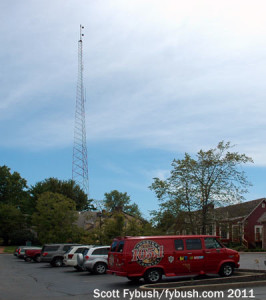

But we do get to show you the other major commercial group in town, at least.
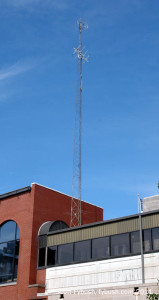

Artistic Media Partners is based up in South Bend, where Art Angotti and his son Arthur control a cluster that includes legendary top-40 signal WNDV (“U93”). It has owned stations in Fort Wayne in the past, and it still runs a cluster over in Lafayette that includes another well-known top-40 signal, WAZY (96.5).
There’s top-40 at the core of Artistic’s cluster here in Bloomington, where WBWB (96.7) is an oasis of radio stability. Since the day it signed on in July 1978, WBWB’s studio and transmitter have been located right here in the Century Village shopping/office complex on SR 446, just off the SR 46 bypass in the northeastern corner of Bloomington.
In more recent years, Artistic has added a second station here. WHCC (105.1) is licensed to – and transmits from – Ellettsville, out to the northwest. Known originally as WZYG and then WGCT, since 2002 it’s been “Hoosier Country 105.1,” competing for Bloomington listeners against rimshot signals from WKKG (101.5) 30 miles away in Columbus and Mid-America’s WCBK (102.3) 20 miles to the north in Martinsville.
The WBWB/WHCC studio in Century Village is compact indeed, and a bit unusual: sales and business offices are on the main floor, while the studios are down a flight of stairs in the cozy, carpeted basement. Whatever was down here in 1978 when WBWB went on the air has long since been replaced by a more modern facility with Harris Airwave Digital consoles.
Across the parking lot, WBWB’s transmitter room sits in a shed below the self-supporting tower: there’s the old RCA transmitter that was, I think, original to 1978, now serving as backup to a Harris Z2CD. And what’s that in the rack in between? One of the first Omnia.11 processors we’ve seen (and heard) in the wild.
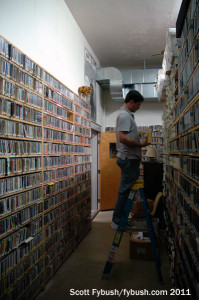

From WBWB and WHCC out on the suburban edge of Bloomington, it’s a fairly big cultural gap to our next stops downtown.
Sarkes Tarzian is a famous name in Bloomington broadcasting: this was the home base for the renowned inventor and manufacturer, who went from working for RCA (and Atwater Kent before that) to running his own company here. As a manufacturer, Sarkes Tarzian made TV sets for consumers and cameras and other gear for broadcasters. As a broadcaster himself, Tarzian put the state’s second TV station on the air here in 1949. WTTV (Channel 10) migrated northward into the Indianapolis market on channel 4 after just a few years (you can see its current transmitter site here), but Tarzian also owned radio, and that stayed in Bloomington. WTTS (1370) signed on in 1949 as one of three post-war AMs on the Bloomington dial, alongside WSUA (1010) and WTOM (1490). Going from no AMs to three was apparently more than the market could bear, and by 1951 both WSUA and WTOM had gone silent, leaving only WTTS behind.
That remaining AM signal changed calls over the years, becoming WGTS and then WGCL; it spawned a sister station, WTTV-FM (92.3), in 1967. The FM station now bears the WTTS calls and targets its AAA format at both Bloomington and Indianapolis, with studios and sales offices in both cities. Its Bloomington office is on the top floor of One City Center, a former Masonic lodge. WGCL is Bloomington’s news-talk voice, with a strong sports presence and a translator on 95.9 to cover the city.
As noted above, we don’t have any photos of WGCL/WTTS to show you (which is too bad, since their studios boast a neat view of downtown and an attractive layout with an elevated central pod for WGCL’s program hosts). But we do have plenty of photos to show you of another station just down the street.
When a community station came to town in 1993, it needed a set of call letters – and it found a great one in its studio location. The new signal on 91.3 made its home base in a converted firehouse at 108 W. Fourth Street, which explains why “Firehouse Broadcasting” dubbed its new station WFHB.
Constrained by spacing issues, WFHB’s 1600-watt main signal on 91.3 comes from a site down in the far southwestern corner of Monroe County, and since this part of Indiana has actual terrain, it can be a tough catch right in the heart of Bloomington. As a result, the Firehouse folks added translators over the years, including 250-watt W251AG on 98.1 from the STL tower right next door to the WFHB studios. (There are also translators serving the outlying communities of Nashville and Ellettsville.)
So what’s inside the firehouse? Passers-by can’t see too much through the two big red firehouse doors that front on Fourth Street; they’ve been walled off inside to soundproof the studios behind them, but if you peer carefully, you can pick out a big stuffed Dalmatian, the station’s mascot, right inside the glass.
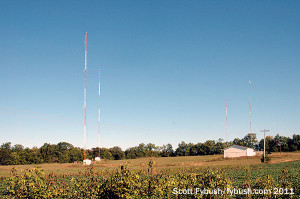

Inside, the old fire truck bays have been partitioned off into a series of smaller studios off to the right of the entrance door and office hallway. There’s a live air studio, an adjoining production room with space for WFHB’s talk shows, and a live performance room for the local music that fills much of WFHB’s schedule. Behind the studios, all that height in the old truck bays works out nicely for the tall shelves of the WFHB record library, filled to the rafters with LPs and CDs.
Oh, and about that office hallway? It includes a newsroom, and a serious one, too: unlike many community stations, WFHB is as committed to news as it is to music, with a daily local newscast and several longer weekly programs.
There’s one more stop along our Bloomington journey before we hit the rolling road down toward Evansville.
WGCL’s four-tower transmitter site sits out on Vernal Pike, west of Bloomington and south of Ellettsville. From here, AM 1370 uses two towers to send its 5000 daytime watts eastward into town; at night, all four towers are used for the 500-watt night signal that’s aimed east and west with a small northward lobe, nulling co-channel stations in Toledo, Dubuque and Chattanooga.
Thanks to Jim Wodock, GM of WBWB/WHCC and Chad Carrothers, GM of WFHB, for the tours!
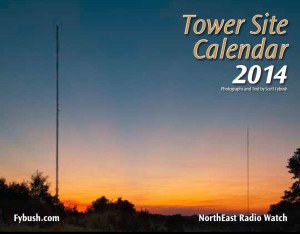

But the wait is over. The Tower Site Calendar, 2014 edition, has gone to press, and you can be the first to reserve your very own. We expect delivery at the end of the month, and we’ll send them right off to their loving homes, spiral bound, shrink wrapped and best of all, with a convenient hole for hanging!
This year’s gorgeous electronic pinups include the iconic towers of Catalina Island, a combiner system in St. Louis, the twin towers of KNRS in Salt Lake City, a historic rooftop site in Jamestown, New York and many more!
If you want a tower calendar on your wall NOW, you can pick up the current edition for just $5 with your 2014 order!
Click here to order your new calendar!
Then check out our store page for our other great merchandise, including the last-ever FM Atlas, the new NRC AM Log and a model of the KSAN tower.
And don’t miss a big batch of cross-country IDs next Wednesday, over at our sister site, TopHour.com!
Next week: Jasper to Evansville, Indiana
In this week’s issue… "Hot" cools down in Providence, CT studios closed - GBH to sell Cape studios - A HEBA in Hamden? - New HDs in New York - Another Canadian AM to close
In this week’s issue… GBH shuffles mornings, prepares new show launches - NYSBA inducts Hall of Famers - More news-talk in the Hudson Valley - Remembering Dan Sys
In this week’s issue… Beasley cuts claim veteran jock - FCC releases LPFM decisions - AM towers coming down - New voices at Indie 88
In this week’s issue… Remembering J.J. Jeffrey, Canada's Bullard - Cumulus surrenders WFAS license - 7 Mountains shuffles Hornell, Mansfield signals - TV director's death cancels newscast